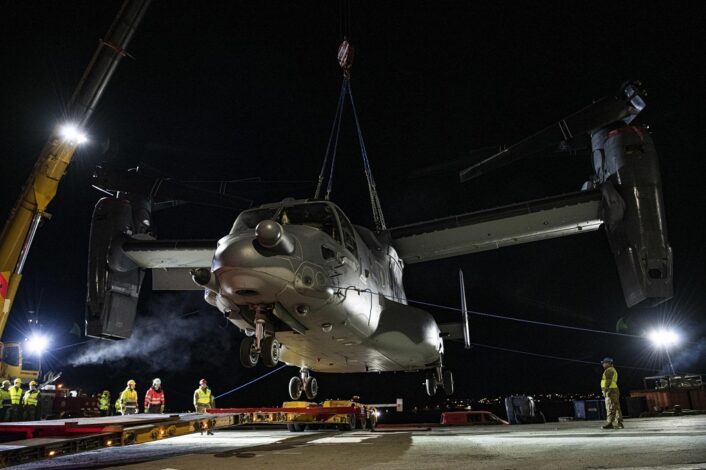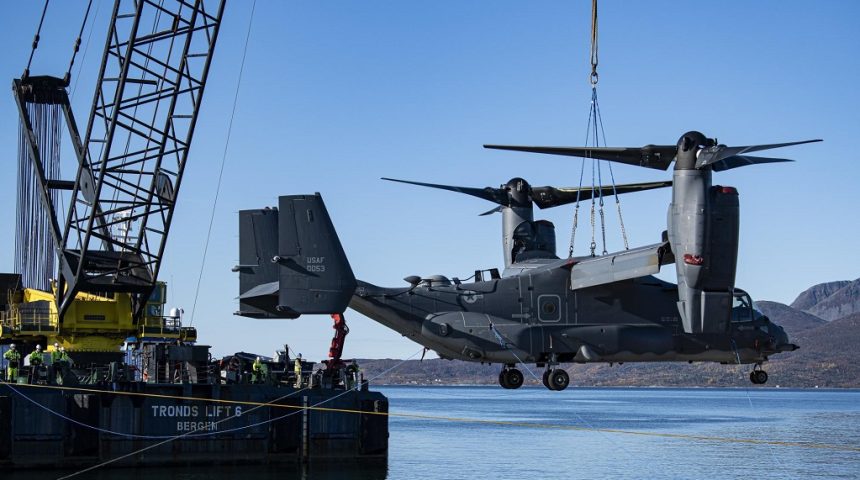The tiltrotor was stuck in the Norwegian wilderness for six weeks after an emergency landing.
A CV-22B Osprey tiltrotor aircraft, belonging to RAF Mildenhall’s 352nd Special Operations Wing, was stranded in the Norwegian wilderness after an emergency landing on Aug. 12, 2022. The Osprey was stuck in the Stongodden nature reserve on the island of Senja for six weeks, until the US and Norwegian militaries were able to finally recover it.
The CV-22, assigned to the 7th Special Operations Squadron, was involved in a training exercise when the emergency happened. The aircraft experienced a “hard clutch engagement”, which prompted the crew to immediately land as part of the emergency checklist. The incident was the second hard clutch engagement in six weeks, and the command therefore ordered a temporary safety stand-down of its 52 Ospreys.
As we already reported, hard clutch engagement occurs when the clutch connecting the propeller’s gear box to its engine slips and the Osprey transfers the power load from that engine to the other one, allowing it to keep flying in the event of an engine failure, and then the power load in transferred back to the original engine as its clutch engages again. The large transfer of torque between the two engines within a span of milliseconds throws the aircraft off balance.
Update 20 sep: Saving the US Osprey at Senja. The 🇳🇴Armed Forces Salvage Battalion has moved the Osprey around 17 meters up onto the makeshift path made by the Army’s Engineer Battalion.
Makeshift path is nearing completion. 📸 Forsvaret/Tiril H. @ryankakiuchan pic.twitter.com/l0cYvrVW1E
— Selshevneren (@selshevneren) September 21, 2022
(1/2) Update 25 sep: Rescue US Osprey at Senja. Operation halted again, due to big waves/strond wind. mac 0.3 wave height and no more than 7 sec/meter wind. 📸Forsvaret. @ryankakiuchan pic.twitter.com/HijM4toBbt
— Selshevneren (@selshevneren) September 25, 2022
The Norwegian Armed Forces worked with the local environmental protection office to plan the recovery of the Osprey from the nature reserve, in collaboration with the U.S. Air Force. The proposed plan was said to be incredibly complicated and something neither the Norwegian nor the Americans have done before. The plan, in fact, involved the creation of a small wooden road to protect vulnerable wildlife at the reserve without destroying the terrain while the aircraft was moved closer to shore.
“It [was very] demanding,” said Royal Norwegian Air Force Command Sergeant Major Odd Helge Wang. “The challenge [was how] shallow [the area was], and the machine weighs 20 tons.” Many obstacles stood in the team’s way to recovering the CV-22, including weather delays and the more sensitive hurdle of preventing damage to the local fauna. “[We’ve brought] 430 tons of equipment in to carry this out, so there will be some wear and tear,” Wang said. “We have tried to do everything as gently as possible.”

The recovery operation started on September 12 at the NATO port in Sørreisa, where equipment and materials were readied for transport and loaded onto a barge. The equipment included an excavator, crane, small bobcat and wooden mats. Severe weather initially delayed the arrival of the crane barge, with the recovery effort also postponed a day because of rough weather, which created 6-foot-high waves off the rocky shore.
Soldiers from Norwegian Army Engineer Battalion were in charge of the construction of the wooden road. By the time the works started on September 14, all fuel had been drained from the Osprey, making it lighter and safer to move. The aircraft was then dug from the ground and moved up about 55 feet toward the bay via the makeshift road, where the crane barge was waiting to pick it up.
As we reported, disassembling the CV-22 was ruled out due to concerns of the aircraft becoming unbalanced and toppling over. Lifting it on the boat was not an easy task, as the Osprey weighs about 20 tonnes and, because of the very shallow waters, a 70-metre-long crane arm had to be used. On September 27, after multiple delays due to the adverse weather, the CV-22 was finally lifted up aboard the barge.
Update 27 sept: Rescue US Osprey. The US CV-22B Osprey of 7th Special Operations Squadron based at RAF Mildenhall is airborn again. Lifting seems to go at plan. 📸 Nordlys. @Forsvaret_no @ryankakiuchan @MatchlessMan410 @NavyLookout pic.twitter.com/Jzs9FdqfED
— Selshevneren (@selshevneren) September 27, 2022
“I’m so impressed by all parties involved who came together to make this recovery operation a success,” said U.S. Air Force Lt. Col. Jeffrey Westerman, recovery mission commander for the 352nd Special Operations Wing. “This monumental operation wouldn’t have been possible without the hard work and dedication from our allies and our Air Commandos, and we are immensely grateful for everything the Norwegians have provided our team during the past weeks.”
After the barge returned to the port, the aircraft was loaded on a truck and transported to a nearby Norwegian military base. According to the Air Force Special Operations Command, the CV-22 has now been recovered inside a hangar, where the maintenance crews will work to repair the aircraft so it may fly again. When accomplished, the Osprey will return to its home station in the United Kingdom.









